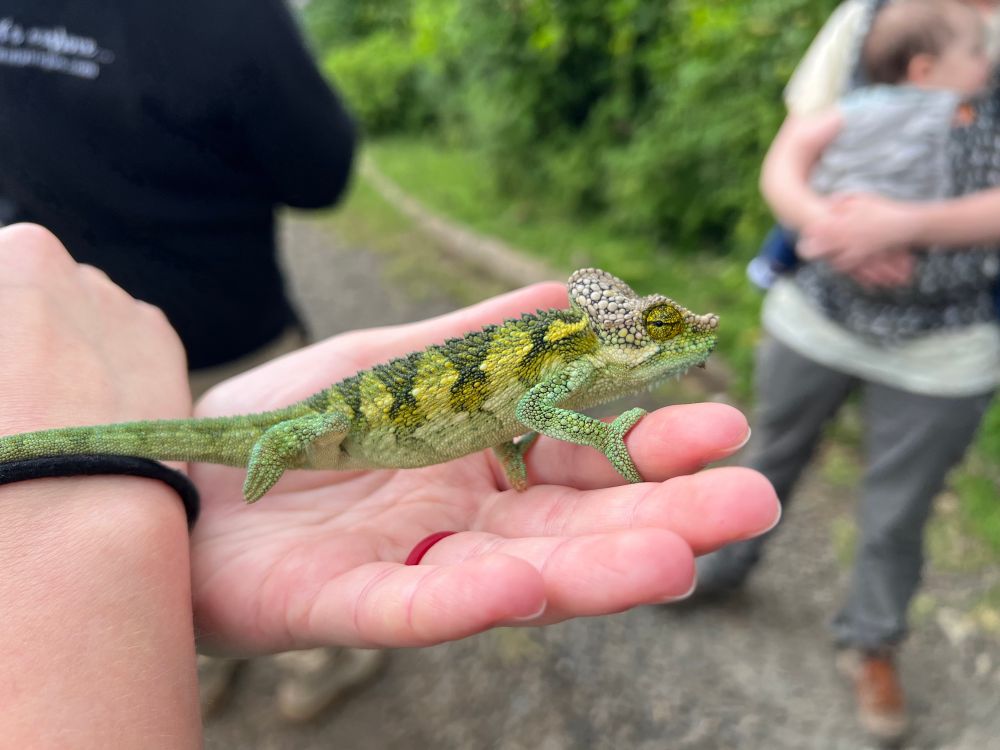
IUCN SSC Chameleon Specialist Group
@iucnchameleons.bsky.social
The Chameleon Specialist Group is a network of dedicated experts who promote, and support, the conservation and sustainable use of wild chameleons.
A study finds that chameleons have longer & more coiled optic nerves than other squamates & known tetrapods, providing slack & reduced strain during extensive eye rotation characteristic of chameleon eyes, & providing an excellent historical review of our knowledge.
www.nature.com/articles/s41...
www.nature.com/articles/s41...

November 10, 2025 at 9:52 PM
A study finds that chameleons have longer & more coiled optic nerves than other squamates & known tetrapods, providing slack & reduced strain during extensive eye rotation characteristic of chameleon eyes, & providing an excellent historical review of our knowledge.
www.nature.com/articles/s41...
www.nature.com/articles/s41...
A study finds that Calumma nasutum is actually a C. gallus complex species lacking the group's elongated rostral appendage & clarify its taxonomy, describing a new species (C. hofreiteri) for populations previously considered under the name C. nasutum.
www.salamandra-journal.com/index.php/co...
www.salamandra-journal.com/index.php/co...

October 30, 2025 at 4:39 PM
A study finds that Calumma nasutum is actually a C. gallus complex species lacking the group's elongated rostral appendage & clarify its taxonomy, describing a new species (C. hofreiteri) for populations previously considered under the name C. nasutum.
www.salamandra-journal.com/index.php/co...
www.salamandra-journal.com/index.php/co...
A profile on C. calyptratus highlights aspects of their biology w/reference to its potentially invasive status in Florida, where the species has been reported in 26 counties, providing insights on management methods & potential ecological impacts.
bioone.org/journals/sou...
bioone.org/journals/sou...

October 20, 2025 at 9:43 PM
A profile on C. calyptratus highlights aspects of their biology w/reference to its potentially invasive status in Florida, where the species has been reported in 26 counties, providing insights on management methods & potential ecological impacts.
bioone.org/journals/sou...
bioone.org/journals/sou...
A study examining restabilization performance in 3 arboreal lizards w/different body & tail configurations following unexpected arboreal perturbations finds that chameleons have larger CoM divergence angles than 2 species with sprawling body configurations.
onlinelibrary.wiley.com/doi/full/10....
onlinelibrary.wiley.com/doi/full/10....

October 20, 2025 at 9:33 PM
A study examining restabilization performance in 3 arboreal lizards w/different body & tail configurations following unexpected arboreal perturbations finds that chameleons have larger CoM divergence angles than 2 species with sprawling body configurations.
onlinelibrary.wiley.com/doi/full/10....
onlinelibrary.wiley.com/doi/full/10....
122 cases of limb loss in lizards revealed that these these rare survivors of traumatic injuries can run just as fast, maintain healthy body weight, reproduce successfully & live surprisingly long lives.
Article: www.journals.uchicago.edu/doi/10.1086/...
Summary: theconversation.com/3-legged-liz...
Article: www.journals.uchicago.edu/doi/10.1086/...
Summary: theconversation.com/3-legged-liz...

October 13, 2025 at 2:43 PM
122 cases of limb loss in lizards revealed that these these rare survivors of traumatic injuries can run just as fast, maintain healthy body weight, reproduce successfully & live surprisingly long lives.
Article: www.journals.uchicago.edu/doi/10.1086/...
Summary: theconversation.com/3-legged-liz...
Article: www.journals.uchicago.edu/doi/10.1086/...
Summary: theconversation.com/3-legged-liz...
A new geographic distribution in the latest issue of African Herp News details new records of Rieppeleon brachyurus in Mozambique, including the first record south of the Zambezi River.
African Herp News is available to HAA members or publicly after ~1 yr: africanherpetology.org/african-herp...
African Herp News is available to HAA members or publicly after ~1 yr: africanherpetology.org/african-herp...

September 30, 2025 at 4:47 PM
A new geographic distribution in the latest issue of African Herp News details new records of Rieppeleon brachyurus in Mozambique, including the first record south of the Zambezi River.
African Herp News is available to HAA members or publicly after ~1 yr: africanherpetology.org/african-herp...
African Herp News is available to HAA members or publicly after ~1 yr: africanherpetology.org/african-herp...
A new note details egg-laying in Chamaeleo dilepis in Kenya, documenting the process from excavation through departure, noting female color changes & local superstitions about finding a digging chameleon.
African Herp News is available after ~1 year: africanherpetology.org/african-herp...
African Herp News is available after ~1 year: africanherpetology.org/african-herp...

September 30, 2025 at 4:29 PM
A new note details egg-laying in Chamaeleo dilepis in Kenya, documenting the process from excavation through departure, noting female color changes & local superstitions about finding a digging chameleon.
African Herp News is available after ~1 year: africanherpetology.org/african-herp...
African Herp News is available after ~1 year: africanherpetology.org/african-herp...
A reevaluation of chameleon foraging mode using movement- & attack-based indices. Chameleons spent most of the day in stationary positions & fed more when stationary than when moving, suggesting they should be considered ambush foragers rather than "cruise foragers".
academic.oup.com/cz/advance-a...
academic.oup.com/cz/advance-a...

September 20, 2025 at 7:54 PM
A reevaluation of chameleon foraging mode using movement- & attack-based indices. Chameleons spent most of the day in stationary positions & fed more when stationary than when moving, suggesting they should be considered ambush foragers rather than "cruise foragers".
academic.oup.com/cz/advance-a...
academic.oup.com/cz/advance-a...
Chameleons & salamanders evolved a sliding-based linear actuator to launch the tongue via muscular squeezing of a tapered skeletal rod, contrasting with tendon-driven pulling mechanisms common in most musculoskeletal systems, allowing acceleration along a straight path.
www.cell.com/current-biol...
www.cell.com/current-biol...

August 28, 2025 at 9:40 PM
Chameleons & salamanders evolved a sliding-based linear actuator to launch the tongue via muscular squeezing of a tapered skeletal rod, contrasting with tendon-driven pulling mechanisms common in most musculoskeletal systems, allowing acceleration along a straight path.
www.cell.com/current-biol...
www.cell.com/current-biol...
A study on the embryonic development of the gonads in chameleons finds that the gonadal primordia appear quickly in development compared to somatic tissue development & the process of gonadal sex differentiation is consistent with other vertebrates
anatomypubs.onlinelibrary.wiley.com/doi/full/10....
anatomypubs.onlinelibrary.wiley.com/doi/full/10....

August 23, 2025 at 4:13 AM
A study on the embryonic development of the gonads in chameleons finds that the gonadal primordia appear quickly in development compared to somatic tissue development & the process of gonadal sex differentiation is consistent with other vertebrates
anatomypubs.onlinelibrary.wiley.com/doi/full/10....
anatomypubs.onlinelibrary.wiley.com/doi/full/10....
A new article documents a new locality for the Endangered Calumma vencesi in the Sorata Forest of NE Madagascar. Their presence supports the need to conserve this valuable mountain forest, which is also home to the likely Critically Endangered Brookesia nana.
www.biotaxa.org/hn/article/v...
www.biotaxa.org/hn/article/v...

August 22, 2025 at 3:35 AM
A new article documents a new locality for the Endangered Calumma vencesi in the Sorata Forest of NE Madagascar. Their presence supports the need to conserve this valuable mountain forest, which is also home to the likely Critically Endangered Brookesia nana.
www.biotaxa.org/hn/article/v...
www.biotaxa.org/hn/article/v...
A new article provides reference sonographic data on the urogenital tracts of veiled and panther chameleons to compare their kidneys, testes, and ovaries to other lizards, although data on the ovaries of female chameleons could not be collected.
Article: onlinelibrary.wiley.com/doi/10.1111/...
Article: onlinelibrary.wiley.com/doi/10.1111/...

August 18, 2025 at 8:24 PM
A new article provides reference sonographic data on the urogenital tracts of veiled and panther chameleons to compare their kidneys, testes, and ovaries to other lizards, although data on the ovaries of female chameleons could not be collected.
Article: onlinelibrary.wiley.com/doi/10.1111/...
Article: onlinelibrary.wiley.com/doi/10.1111/...
Distance from highways & lower proportions of ground covered by shrubs are associated with higher favorability for the presence of C. chamaeleon. In Spain this species is largely restricted to highly anthropized coastal areas with high road density... conbio.onlinelibrary.wiley.com/doi/full/10....

August 15, 2025 at 4:55 PM
Distance from highways & lower proportions of ground covered by shrubs are associated with higher favorability for the presence of C. chamaeleon. In Spain this species is largely restricted to highly anthropized coastal areas with high road density... conbio.onlinelibrary.wiley.com/doi/full/10....
Chameleons & agamid lizards diverge in tooth proteins involved in strengthening enamel structure. Chameleons are more divergent in enamel matrix proteins which may be associated with a more complete transition to monophyodont dentition than agamids.
Article: link.springer.com/article/10.1...
Article: link.springer.com/article/10.1...

August 13, 2025 at 5:27 PM
Chameleons & agamid lizards diverge in tooth proteins involved in strengthening enamel structure. Chameleons are more divergent in enamel matrix proteins which may be associated with a more complete transition to monophyodont dentition than agamids.
Article: link.springer.com/article/10.1...
Article: link.springer.com/article/10.1...
A new publication reports on a novel host record of a tick species that commonly infests tortoises and some lizards feeding on a Mediterranean Chameleon (Chamaeleo chamaeleon recticrista) in Turkey with attachment to the margin of the eye turret.
Article: www.researchgate.net/profile/Goek...
Article: www.researchgate.net/profile/Goek...

August 13, 2025 at 4:54 PM
A new publication reports on a novel host record of a tick species that commonly infests tortoises and some lizards feeding on a Mediterranean Chameleon (Chamaeleo chamaeleon recticrista) in Turkey with attachment to the margin of the eye turret.
Article: www.researchgate.net/profile/Goek...
Article: www.researchgate.net/profile/Goek...
A study on societal impacts of introduced populations of F. pardalis in Florida found that residents knew of but expressed low concern about the chameleons' presence, expressing more concern for their safety given the activities of private collectors.
digitalcommons.usu.edu/cgi/viewcont...
digitalcommons.usu.edu/cgi/viewcont...

August 6, 2025 at 4:33 PM
A study on societal impacts of introduced populations of F. pardalis in Florida found that residents knew of but expressed low concern about the chameleons' presence, expressing more concern for their safety given the activities of private collectors.
digitalcommons.usu.edu/cgi/viewcont...
digitalcommons.usu.edu/cgi/viewcont...
A new study finds that C. dilepis change their brightness to better match black backgrounds & change color to match some hues, especially yellow, although not matching background patterns.
Article: royalsocietypublishing.org/doi/10.1098/...
Article: royalsocietypublishing.org/doi/10.1098/...

August 6, 2025 at 3:59 PM
A new study finds that C. dilepis change their brightness to better match black backgrounds & change color to match some hues, especially yellow, although not matching background patterns.
Article: royalsocietypublishing.org/doi/10.1098/...
Article: royalsocietypublishing.org/doi/10.1098/...
Some hopeful news on the Critically Endangered Furcifer belalandaensis, which was recently discovered in some less disturbed habitat than it has previously been known from, possibly providing an opportunity to better protect the species!
Article: greenauve.org/new-hope-for...
Article: greenauve.org/new-hope-for...

August 6, 2025 at 4:22 AM
Some hopeful news on the Critically Endangered Furcifer belalandaensis, which was recently discovered in some less disturbed habitat than it has previously been known from, possibly providing an opportunity to better protect the species!
Article: greenauve.org/new-hope-for...
Article: greenauve.org/new-hope-for...
Reposted by IUCN SSC Chameleon Specialist Group
A clutch of Bradypodion cf. melanocephalum “Hilton” born in the lab today! Immediately getting some metabolic rate data from them to follow through ontogeny! Have also been getting metabolic rate data from the mother for the last 3 months and will continue as she recovers from birth as well!



July 26, 2025 at 12:19 AM
A clutch of Bradypodion cf. melanocephalum “Hilton” born in the lab today! Immediately getting some metabolic rate data from them to follow through ontogeny! Have also been getting metabolic rate data from the mother for the last 3 months and will continue as she recovers from birth as well!
Study on convergent evolution & ecological speciation in Bradypodion finds differences in functional traits related to grip can be explained by the perch diameters used, whereas ornamentation differs in different habitats but is convergent in similar habitats.
Link: zse.pensoft.net/article/1519...
Link: zse.pensoft.net/article/1519...

July 23, 2025 at 3:36 AM
Study on convergent evolution & ecological speciation in Bradypodion finds differences in functional traits related to grip can be explained by the perch diameters used, whereas ornamentation differs in different habitats but is convergent in similar habitats.
Link: zse.pensoft.net/article/1519...
Link: zse.pensoft.net/article/1519...
Reposted by IUCN SSC Chameleon Specialist Group
Two female Trioceros jacksonii, which appear to be T. j. xantholophus with rostral horns, from 2,130m elevation on the western/southwestern slopes of Mount Kenya.


May 31, 2025 at 8:08 AM
Two female Trioceros jacksonii, which appear to be T. j. xantholophus with rostral horns, from 2,130m elevation on the western/southwestern slopes of Mount Kenya.
Reposted by IUCN SSC Chameleon Specialist Group
Trioceros hoehnelii from 2,130m elevation on the western/southwestern slopes of Mount Kenya!



May 31, 2025 at 6:52 AM
Trioceros hoehnelii from 2,130m elevation on the western/southwestern slopes of Mount Kenya!
Reposted by IUCN SSC Chameleon Specialist Group
Some Trioceros hoehnelii from the Naro Moru route on Mount Kenya!



May 31, 2025 at 6:51 AM
Some Trioceros hoehnelii from the Naro Moru route on Mount Kenya!
Reposted by IUCN SSC Chameleon Specialist Group
High-casqued Chameleons (Trioceros hoehnelii)!



May 27, 2025 at 12:37 PM
High-casqued Chameleons (Trioceros hoehnelii)!
Reposted by IUCN SSC Chameleon Specialist Group
Aberdares Montane Dwarf Chameleon (Trioceros kinangopensis)!



May 27, 2025 at 1:51 PM
Aberdares Montane Dwarf Chameleon (Trioceros kinangopensis)!

